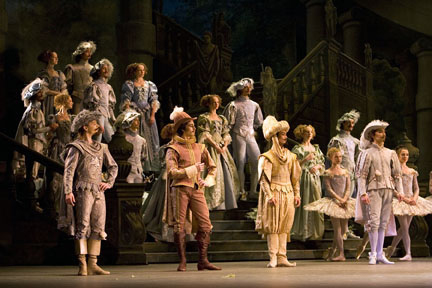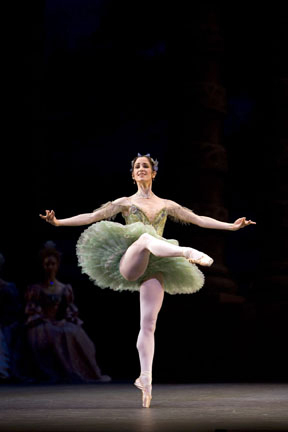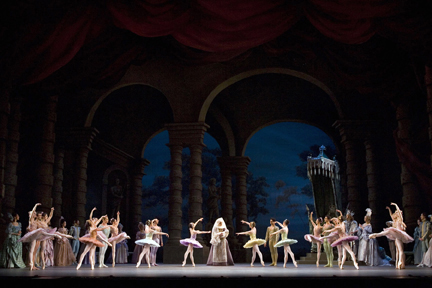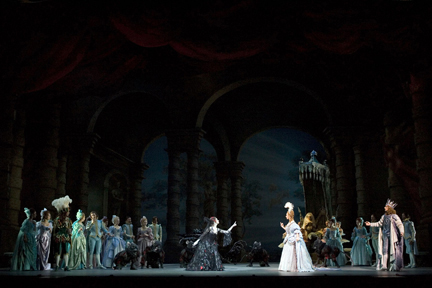Could do better
"The Sleeping Beauty"
Royal Ballet
Covent Garden Opera House
London
15 May to 3 June, 2006
by John Percival
copyright ©2006, John Percival
 How happy we were when Monica Mason announced that the Royal Ballet, to
celebrate its 75th birthday, would mount a new production of "The Sleeping
Beauty" trying to restore the qualities that won the company national and
international fame. More than any of the other old Russian classics, it
was "Beauty", together with our distinctive Ashton ballets, that set the
company style. And the version premiered in 1946 for the move to Covent
Garden Opera House remains, together with the Kirov's recent attempt to
approximate Petipa's original, the supreme exposition of what this great
ballet is really about.
How happy we were when Monica Mason announced that the Royal Ballet, to
celebrate its 75th birthday, would mount a new production of "The Sleeping
Beauty" trying to restore the qualities that won the company national and
international fame. More than any of the other old Russian classics, it
was "Beauty", together with our distinctive Ashton ballets, that set the
company style. And the version premiered in 1946 for the move to Covent
Garden Opera House remains, together with the Kirov's recent attempt to
approximate Petipa's original, the supreme exposition of what this great
ballet is really about.
As the only complete collaboration of imperial Russia's greatest choreographer, Petipa, and greatest ballet composer, Tchaikovsky, the work marks a peak. When the Diaghilev Ballet in 1921-22 introduced it to British audiences with a three-month London season, young Ninette de Valois was one who watched and admired; later she danced in Diaghilev's presentation of extracts from it under the title "Aurora's Wedding".
This helped inspire the original (but now widely copied) policy she invented on forming the Vic-Wells Ballet in the 1930s: a mixture of classics and creations. Engaging Nicholas Sergeyev, the former Maryinsky ballet master who had brought choreo-scripts with him on leaving Russia after the revolution, she quickly put on "Coppelia", "Giselle", "Nutcracker" and "Swan Lake", initially in cut-down stagings. But from "Beauty" (which he had mounted for Diaghilev) she at first took only the Bluebird and Aurora pas de deux, initially in 1933 for Markova and Idzikovsky, soon followed by other casts. The full "Beauty" had to wait until 1939 when the company was stronger and the Sadler's Wells stage slightly enlarged.
 Since Diaghilev had substituted some dances from other ballets, had
Stravinsky orchestrate some numbers, and commissioned some new choreography
from Bronsislava Nijinska, that first Sadler's Wells staging may have been
the most faithful outside Russia until then. It ran twelve times at the
Wells that season (a lot in those days of sharing the theatre). Moreover,
two Acts were given at a Covent Garden gala honouring the French president,
then repeated twice on television. Came the war, and they still managed to
give 44 more performances 1940-42, although the production was progressively
cut down as male dancers were conscripted. Fonteyn and Helpmann danced
almost every show.
Since Diaghilev had substituted some dances from other ballets, had
Stravinsky orchestrate some numbers, and commissioned some new choreography
from Bronsislava Nijinska, that first Sadler's Wells staging may have been
the most faithful outside Russia until then. It ran twelve times at the
Wells that season (a lot in those days of sharing the theatre). Moreover,
two Acts were given at a Covent Garden gala honouring the French president,
then repeated twice on television. Came the war, and they still managed to
give 44 more performances 1940-42, although the production was progressively
cut down as male dancers were conscripted. Fonteyn and Helpmann danced
almost every show.
With hindsight, a new, bigger and better "Sleeping Beauty" seems the inevitable choice for the 1946 move to Covent Garden, but it was a brave venture for de Valois's war-weary company, even though she knew "that we had outgrown the Sadler's Wells theatre in size; that we were ripe, at this very moment, for further expansion". The dancers were high-spirited: many of them recently back from war service, others (notably teen-ager Beryl Grey and Moira Shearer, just 20) ready for more responsibility, and quite a few newly recruited, including the young Bolshoi ballerina Violetta Prokhorova (later Elvin). Who could have guessed, however, just how successful a production it would prove for the two Royal companies: given — uniquely — every single year until 1970 (yes, that's 25 consecutive years) and reaching well over 1100 performances.
The most cogent factor in effecting a transformation was Oliver Messel 's new design. De Valois in 1939 had wanted her "Beauty" to avoid the excessive heaviness (literal and metaphorical) of Diaghilev's. But, partly for lack of funds and space, Nadia Benois's designs erred too far in the other direction. Messel hit the spot exactly: magnificent but not over-powering. The great effects of architecture, fountains etc. were largely painted, not built, so they didn't monopolise space. And Messel took enormous trouble over the costumes, making the most of rationed materials, and even saving costs by making some headdresses himself out of pipe cleaners.
 Music director Constant Lambert worked to ensure the best possible
results from the larger orchestra available (athough interestingly it was
only when the production went to New York three years later that he was
fully acclaimed for this). De Valois herself oversaw the staging. Having
got the traditional choreography from Sergeyev, she did not call him back;
he was now working with International Ballet, and anyway de Valois thought
he lacked understanding of music and of production values, entries, exits
etc. So it was she who ensured stylistic unity while achieving each scene'
s individual quality, to match the value of Petipa's choreography: an
unrivalled amount of pure dancing, each number distinct, imaginative and
expressive, telling the story more in dance than mime, through the big
adagios and solos in each scene.
Music director Constant Lambert worked to ensure the best possible
results from the larger orchestra available (athough interestingly it was
only when the production went to New York three years later that he was
fully acclaimed for this). De Valois herself oversaw the staging. Having
got the traditional choreography from Sergeyev, she did not call him back;
he was now working with International Ballet, and anyway de Valois thought
he lacked understanding of music and of production values, entries, exits
etc. So it was she who ensured stylistic unity while achieving each scene'
s individual quality, to match the value of Petipa's choreography: an
unrivalled amount of pure dancing, each number distinct, imaginative and
expressive, telling the story more in dance than mime, through the big
adagios and solos in each scene.
In 1939, the production had been as close to the original as the company's resources permitted; it even included the dance of Cinderella and her prince in Act 3, omitted postwar, presumably thought too trite. In 1946, a few dances were changed. Ashton made a new garland dance; it had to be for women only, but was very lovely and full of poetry. He also (following Nijinska's Diaghilev precedent) adapted the all-woman Jewel fairies into Florestan and his Sisters. De Valois staged the polonaise and also followed Nijinska in making a three-man Russian dance (the Three Ivans) to the principals' last-act coda music. Perhaps her rationale was that you couldn't have a coda since the Prince didn't then have a solo, but she added one for him in 1952, after Helpmann's retirement. Also then Ashton made a new solo for Aurora in the vision scene, "after Petipa" — using Elvin's Russian memories.
 Other adjustments were made to the production from time to time, but
mostly it continued substantially and recognisably the same all those years. It also continued to this day in the memories of many who watched it again
and again over the years (I know that I must have seen it well over a
hundred times, maybe twice that or even more). So have we really
recaptured the merits of that miraculous old staging? Only partly.
The chief culprit is Peter Farmer, credited with "realizing" Messel's
original designs and with unspecified additional designs. Having now seen
Farmer's contribution five times, I truly believe there is not a single
costume in it that is just as Messel intended. And the changes are not for
the better. Farmer claims that the theory of design has changed and that
we are better off with the more limited range of colour which he provides in
any scene. Oh yes? In my view and that of many others, his costumes give
the ballet a drab, dreary look. The King and Queen, for instance, formerly
regal in purple, now look genteel in pale blue, although His Majesty is
lumbered with a ludicrously tall crown; and why has he no sceptre? I read
claims of preserving Aurora's "iconic" tutu — well, the skirt is different,
and the sleeves are tighter and longer. Carabosse looks like a barmaid,
and the Lilac Fairy's mauve frock proves how right Messel was to provide a
costume with just a lilac edging to an ivory tutu. Surely Catalabutte is
OK, said one colleague. Actually no — his new green breeches are
unnecessary, the feathers in his headdress are overlong, and other detailing
of what used to be a striking and memorable costume is changed. Worst off
is our hero, Prince Florimund, whose wonderful red hunting costume is
replaced by a beige jacket with ludicrous patches on sleeves and edging.
It may be that Farmer knows the costumes only from the American Ballet
Theatre's 1976 revival, which by general opinion was disastrous — wrong
materials, poorly made up ("coarse and dreadful" according to Robert
Helpmann). Messel officially supervised that production but was already
ill and died a couple of years later. But Farmer's claim to interviewers
that Messel wasn't really a designer is unforgivable impertinence.
Other adjustments were made to the production from time to time, but
mostly it continued substantially and recognisably the same all those years. It also continued to this day in the memories of many who watched it again
and again over the years (I know that I must have seen it well over a
hundred times, maybe twice that or even more). So have we really
recaptured the merits of that miraculous old staging? Only partly.
The chief culprit is Peter Farmer, credited with "realizing" Messel's
original designs and with unspecified additional designs. Having now seen
Farmer's contribution five times, I truly believe there is not a single
costume in it that is just as Messel intended. And the changes are not for
the better. Farmer claims that the theory of design has changed and that
we are better off with the more limited range of colour which he provides in
any scene. Oh yes? In my view and that of many others, his costumes give
the ballet a drab, dreary look. The King and Queen, for instance, formerly
regal in purple, now look genteel in pale blue, although His Majesty is
lumbered with a ludicrously tall crown; and why has he no sceptre? I read
claims of preserving Aurora's "iconic" tutu — well, the skirt is different,
and the sleeves are tighter and longer. Carabosse looks like a barmaid,
and the Lilac Fairy's mauve frock proves how right Messel was to provide a
costume with just a lilac edging to an ivory tutu. Surely Catalabutte is
OK, said one colleague. Actually no — his new green breeches are
unnecessary, the feathers in his headdress are overlong, and other detailing
of what used to be a striking and memorable costume is changed. Worst off
is our hero, Prince Florimund, whose wonderful red hunting costume is
replaced by a beige jacket with ludicrous patches on sleeves and edging.
It may be that Farmer knows the costumes only from the American Ballet
Theatre's 1976 revival, which by general opinion was disastrous — wrong
materials, poorly made up ("coarse and dreadful" according to Robert
Helpmann). Messel officially supervised that production but was already
ill and died a couple of years later. But Farmer's claim to interviewers
that Messel wasn't really a designer is unforgivable impertinence.
The settings fare better. I'm puzzled by a new front curtain that appears during the overture and again before Act 3, a very sketchy picture of pillars and a man standing on isolated steps. Is this something Messel started and abandoned as irrelevant, or is it Farmer's invention? Either way, it's pointless and should be removed. Apart from that, the settings for all but Act 2 do give a reasonable approximation of the original splendid architecture (although I miss the painted fountains). Messel's Act 2 (hunt and vision) was I believe adapted from an existing design but its rocks, trees and lake looked just right. However, a panorama proved impractical at the time. By inventing entirely new designs, Farmer has managed a sort of panorama scene, but not a very good one. He also omits the spine-chilling spider's web that used to obstruct the journey to the sleeping palace, and the clumpy boat he provides for part of the journey (left to make its own way off-stage once empty!) can't begin to compare with the delicately magical effect of the Lilac Fairy's former little boat, drawn along by a pair of butterflies.
 And what of the actual staging? It's by Monica Mason and Christopher
Newton, and the outcome is a bit mixed. Prologue: some attention needed.
Why does an attendant announce "The king and queen are coming this way" when
actually they are already entering from another direction? Couldn't the
fairy soloists be more strongly cast (we used often to have principals) and
coached for more differentiation? At the end, it would make more sense to
restore the king's mime proclaiming death for anyone who brings needles to
court.
And what of the actual staging? It's by Monica Mason and Christopher
Newton, and the outcome is a bit mixed. Prologue: some attention needed.
Why does an attendant announce "The king and queen are coming this way" when
actually they are already entering from another direction? Couldn't the
fairy soloists be more strongly cast (we used often to have principals) and
coached for more differentiation? At the end, it would make more sense to
restore the king's mime proclaiming death for anyone who brings needles to
court.
Act 1: there's a new garland dance by Christopher Wheeldon for twelve women and eight men. Much too fussy and prettied up, with dancers running off and on all the time (not something you'd do, surely, when performing for the monarch). The four princes courting Aurora have feeble costumes and an unnoticeable entrance. And they block the way so that Aurora loses her diagonal leaning in turn over four of her friends (who have also lost their musical instruments).
Act 2: disaster! The hunting party have lost almost all their dancing, so their entry seems ludicrously perfunctory, and the blindfolding of Gallison out of proportion (as too is his uniquely long hair). Yet we' ve an added solo for Florimund — danced in his shirtsleeves. It's one that Ashton created for a quite a different production, and as performed at present looks mimsy. How much more effect Robert Helpmann made at that point in 1946 just by acting: he gazed into the distance with his back to the audience but made us feel all the longing that was about to be focused on the vision of Aurora. The panorama I've already mentioned. Awakening — is it perhaps a little heavy handed?
 Act 3: thank goodness, no Three Ivans, so the principals get their
solos and their coda. The court seems underpopulated and the total effect
consequently somewhat lightweight. Apropos of which, I would say that on the
whole the producers and the various coaches listed don't seem to have got
over to the cast as a whole just why this ballet is important, and how it
can be exciting to dance — which in turn would make it more exciting to
watch.
Act 3: thank goodness, no Three Ivans, so the principals get their
solos and their coda. The court seems underpopulated and the total effect
consequently somewhat lightweight. Apropos of which, I would say that on the
whole the producers and the various coaches listed don't seem to have got
over to the cast as a whole just why this ballet is important, and how it
can be exciting to dance — which in turn would make it more exciting to
watch.
We've had five couples in the lead roles. On the first night, Alina Cojocaru's Aurora was nimble, with lots of quick little steps. Don't I remember that Ashton told Fonteyn in 1946 to hold everything a little longer to carry in this house? Still good advice. Tamara Rojo danced brilliantly (astonishing balances and multiple pirouettes); no problem in projecting there. I wasn't bowled over by either Roberto Marquez or Sarah Lamb, both a bit stolid. But Marianela Nunez was irresistible: such warmth, such commitment, such generosity of feeling. Among the Florimunds, Viacheslav Samodurov danced the brightest solo, Thiago Soares acted and partnered most nobly, Federico Bonelli maybe struck the best balance. Alexandra Ansanelli and, more especially, Nunez both did nicely as Lilac Fairy. Elizabeth McGorian was so much livelier than Genesia Rosato as both Carabosse and Queen that it's a shame she can't do both at once. Gary Avis's acting makes more of the King than the production does. I've seen three Bluebirds, none of them impressive, four Florestans, ditto, but Belinda Hatley and young Yuhui Choe do well as Princess Florisse. I wish, I really do, that I could welcome this production more warmly. Will things improve? Probably, but we'll still be lumbered with Farmer's awful costumes.
Photos (all by Bill Cooper) from top:
Thomas Whitehead as the Russian Prince, David Pickering as the Spanish Prince, Yohei Sasaki as the Indian Prince, Bennet Gartside as the French Prince (L to R)
Belinda Hatley as Woodland Glade
The Prologue
Alastair Marriott as Catalabutte
Elizabeth McGorian as Carabosse, Genesia Rosato as the Queen - Prologue
Tamara Rojo as Aurora
Volume 4, No. 21
May 29, 2006
copyright ©2006 John Percival
www.danceviewtimes.com